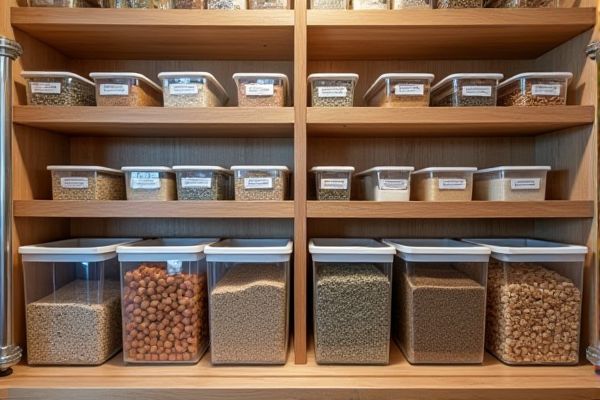
Food safe bins are specifically designed to prevent contamination, using materials that do not leach harmful chemicals and often featuring airtight seals to keep pantry items fresh longer. Understanding the difference between these and regular bins can help you make informed choices for Your pantry organization and food safety--read on to learn more about selecting the best storage options.
Table of Comparison
| Feature | Food Safe Bins | Regular Bins (Pantry) |
|---|---|---|
| Material | BPA-free, food-grade plastic or stainless steel | Standard plastic, metal, or composite materials |
| Safety Certification | FDA approved, complies with food safety standards | No specific food safety certification |
| Odor & Stain Resistance | Resistant to odors and stains, non-porous surfaces | Can absorb odors and stains over time |
| Seal & Freshness | Airtight seals to maintain food freshness | Usually not airtight, limited freshness preservation |
| Durability | Highly durable for long-term food storage | Less durable, mainly for general storage |
| Uses | Storing dry goods, snacks, baking ingredients | Storing household items, non-food materials |
| Cleaning | Easy to clean, dishwasher safe | May retain residues, generally hand wash recommended |
Understanding Food Safe Bins vs Regular Bins
Food safe bins are specifically designed to meet strict hygiene standards, using BPA-free, non-toxic materials that prevent contamination and preserve the freshness of your pantry items. Regular bins often lack these certifications, making them more prone to harboring bacteria and causing spoilage in stored food. Choosing food safe bins ensures your food remains protected, maintaining quality and safety in your kitchen storage.
Key Differences in Materials and Construction
Food safe bins are made from non-toxic, BPA-free plastics that prevent chemical leaching and ensure the freshness of your pantry items. Regular bins often use cheaper materials that may contain harmful chemicals, lacking proper seals or airtight construction. Your choice of food safe bins guarantees better protection against contamination and moisture, preserving the quality and safety of stored food.
Importance of Preventing Food Contamination
Food safe bins are designed with materials that do not leach harmful chemicals, ensuring your pantry items remain uncontaminated and fresh. Unlike regular bins, food safe containers often feature airtight seals that prevent moisture and pests from compromising ingredient quality. Using food safe bins is crucial for maintaining hygiene standards and prolonging the shelf life of your stored food.
Food Safe Bin Certifications and Standards
Food safe bins for pantry storage comply with certifications such as FDA CFR 21 and EU Regulation No 10/2011, ensuring materials are non-toxic and suitable for direct food contact. These standards mandate the use of BPA-free plastics and restrict harmful chemicals to prevent contamination and maintain food safety. Regular bins often lack such certifications, increasing the risk of chemical leaching and compromising food hygiene.
Durability and Longevity: Food Safe vs Regular Bins
Food safe bins are crafted from high-quality, BPA-free materials that resist cracking and warping, ensuring durability and longevity even with frequent washing and use. Regular pantry bins often use lower-grade plastics that can degrade or leach chemicals over time, reducing lifespan and potentially compromising food safety. Investing in food safe containers enhances long-term storage solutions by maintaining structural integrity and protecting food quality.
Moisture and Pest Resistance in Food Storage
Food safe bins are specifically designed to provide superior moisture and pest resistance, ensuring your pantry items remain fresh and uncontaminated. Unlike regular bins, food safe containers feature airtight seals and durable materials that prevent moisture buildup and block infestations from insects and rodents. Choosing food safe bins protects your food storage by maintaining optimal conditions and reducing spoilage risks.
Ease of Cleaning and Maintenance
Food safe bins feature smooth, non-porous surfaces that resist stains and odors, making them significantly easier to clean compared to regular pantry bins. Their design minimizes crevices where food particles and bacteria can accumulate, reducing maintenance efforts and promoting better hygiene. Choosing food safe bins helps you maintain a cleaner pantry environment with less time spent on upkeep.
Cost Comparison: Is the Investment Worth It?
Food safe bins typically cost 20-50% more than regular pantry bins due to their BPA-free materials and FDA-approved certifications, ensuring no harmful chemicals leach into stored food. While the upfront expense is higher, food safe bins provide long-term health benefits and prevent contamination, potentially reducing food waste and replacement costs. Investing in food safe bins is justified by improved food safety and peace of mind, outweighing the initial price difference compared to standard pantry bins.
Best Practices for Organizing Pantry with Food Safe Bins
Food safe bins prevent contamination and preserve freshness by using BPA-free, non-toxic materials designed for direct food contact, unlike regular bins that may leach harmful chemicals. Organizing your pantry with food safe bins involves clear labeling, airtight seals to keep pests out, and stackable designs to maximize space efficiently. Prioritize transparency and size variety to ensure easy access and maintain a hygienic storage environment for your ingredients.
Choosing the Right Bins for Your Pantry Needs
Food safe bins are specifically designed with BPA-free materials that prevent chemical leaching, ensuring the protection of your pantry items from contamination and spoilage. Regular bins often lack airtight seals and food-grade certifications, making them less effective at preserving freshness and preventing pests. Selecting food safe bins with clear labeling and stackable designs optimizes storage efficiency while maintaining the quality and safety of dry goods.
 homyna.com
homyna.com